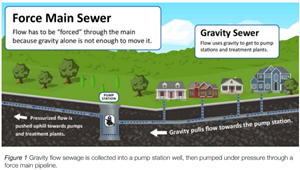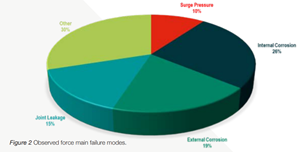August 2023 Vol. 78 No. 8
Features
Tech Tips: Force main rehabilitation
By NASSCO Member Dr. Mark Knight, PhD, FIAM M. ASCE, Associate Professor, Department of Civil and Environmental Engineering, University of Waterloo, Canada.
(UI) — Force mains, also called rising mains in the United Kingdom, are low pressure pipelines that lift the sewage from one location to another by pumping the sewage under positive pressure (Figure 1).
Force mains are constructed with a limited finite length and access, only when a gravity sewer does not have sufficient elevation grade to make gravity sewers flow.
Unlike gravity sewers, force mains flow full with sewage at internal pressures that can vary from 20 to 60 psi. They also are circular pipes, 4 to 36 inches in diameter, that have no lateral connections. Pressure release valves (PVRs) are often installed at high points to release entrapped air and to limit surge pressures when the pump starts.
Frequent pump starts and stops also occur to maintain the sewage level within the well. Force mains should be designed to withstand the normal working pressures, maximum surge pressures, and the frequent turning on and off the pumps that can cause fatigue failures. Pipe materials such as PVC can be susceptible to fatigue failures in force mains.
Force mains are critical components in a successful operating sewage network. Figure 2 provides common failure modes observed in force mains.
To prevent the high consequence of leakage of sewage into the environment, force main should be regularly inspected and renovated, when the condition state falls below an acceptable level. NASSCO’s Pressure Pipe Committee has developed and published a general guidelines matrix for force main pressure pipe inspection. These guidelines are available at NASSCO.org/ Resources.
These general guidelines provide information with respect to different rehabilitation methods’ structural classification, typical diameter ranges, lined Hazen Williams coefficients, connections, and end seals. It also provides additional comments for each rehabilitation method.
NASSCO’s Pressure Pipe Committee is currently working on a white paper that will provide additional information on force main rehabilitation design and construction. This white paper is expected to be published in early 2024.
The Committee also conducted a highly attended webinar titled Trenchless Rehabilitation for Force Mains. The recorded webinar may be viewed at NASSCO.org/resources/webinars.






Comments